|
Cycle 4 (2015 Deadline)
Tropical montane forests and climate change in the Peruvian Andes: Micro-environmental, biotic and human impacts at tree line
PI: Norma Salinas (nsalinasr@pucp.pe), Pontificia Universidad Catolica del Peru
U.S. Partner: Miles Silman, Wake Forest University
Project Dates: October 2015 - July 2022
Project Overview
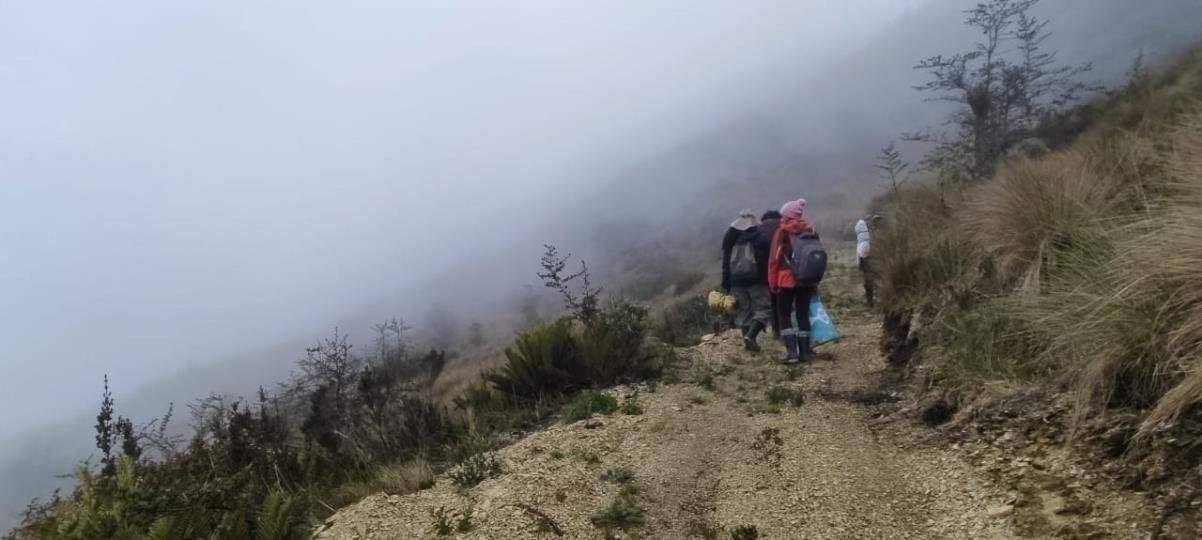 |
| PEER Team heading out to conduct field work. Credit: Norma Salinas 2022 |
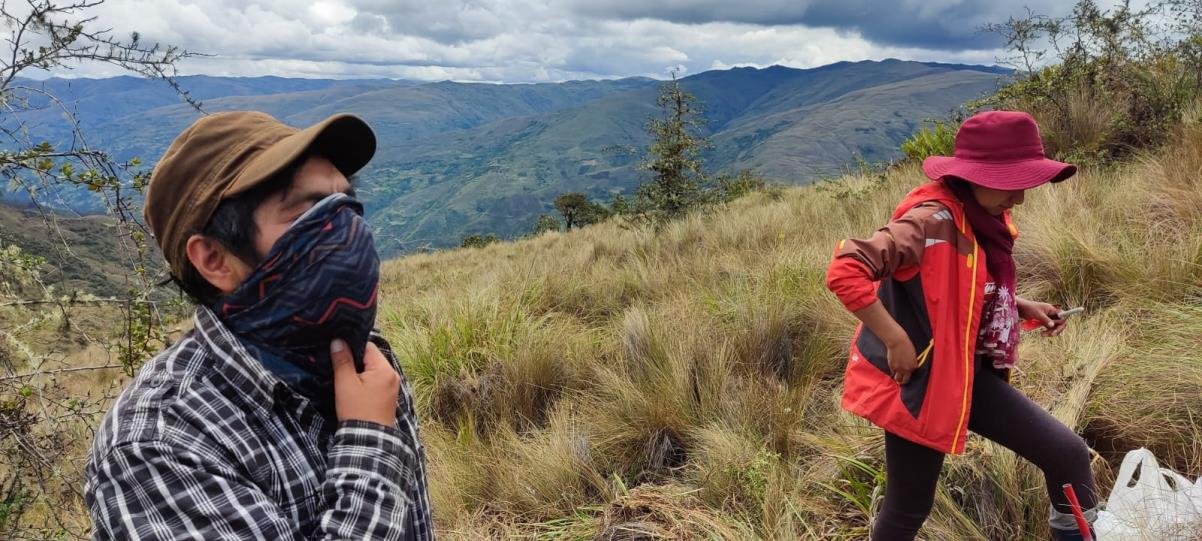 |
| Preparing for the field work. Credit: Norma Salinas, 2022 |
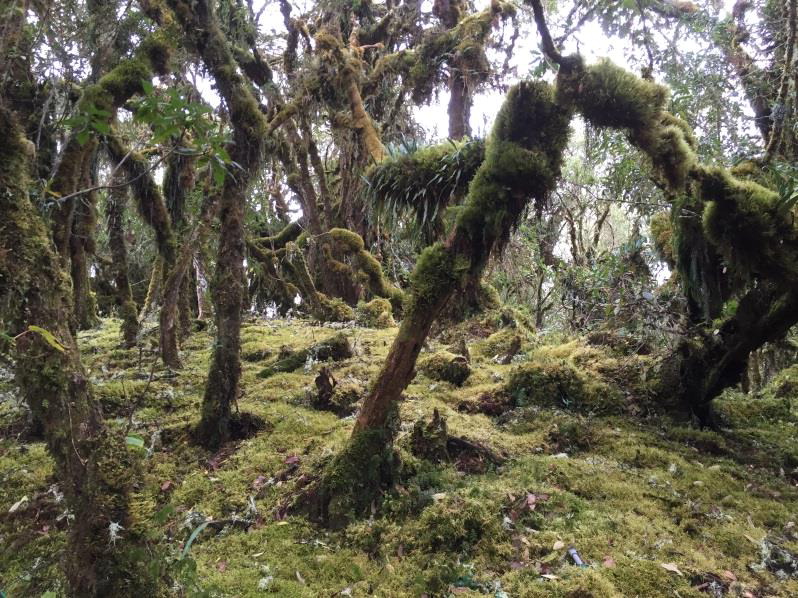 |
| Patch of cloud forest of mixed species at 3500 m in the Tres area |
| |
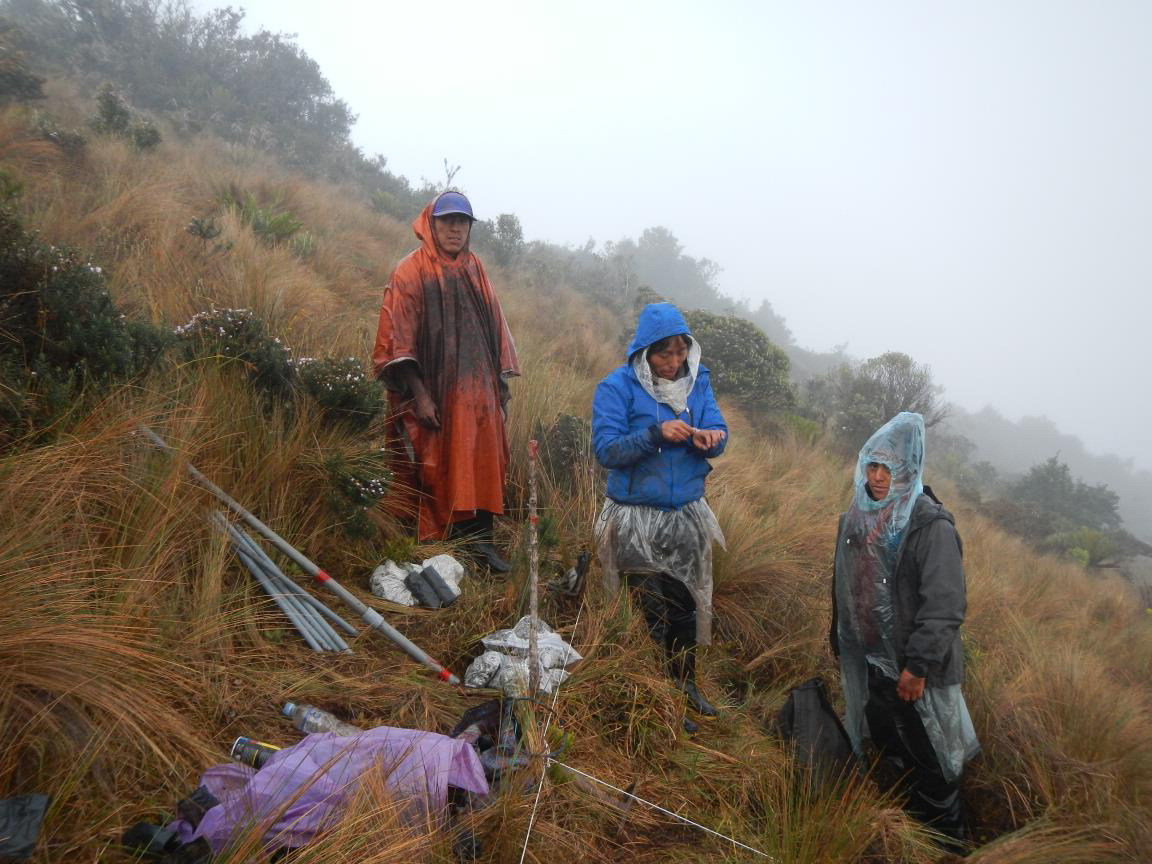 |
| Field assistants and PI transplanting tree seedlings in the upper Manu National Park |
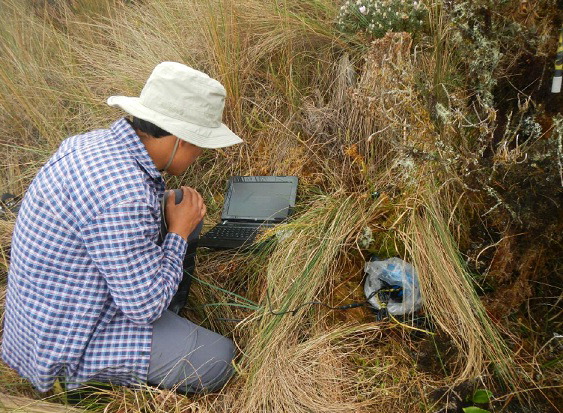 |
| A team member collects environmental data |
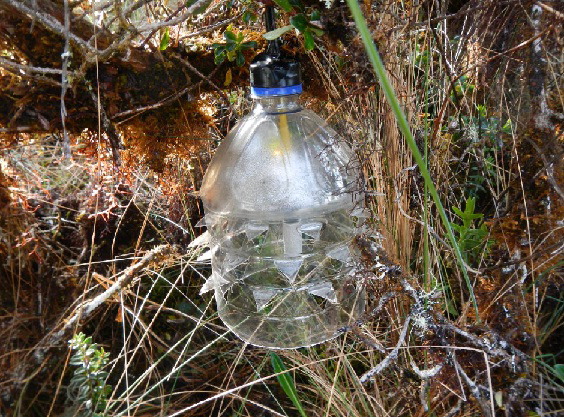 |
| A modified PET plastic water bottle is used as hood for temperature/relative humidity sensors |
Cloud forest environments respond strongly even to small changes in temperature, and a large fraction of species within these environments are vulnerable to extinction due to climate change. Species distributions can be strongly influenced by many factors, including potential ecological barriers and forces driving altitudinal migrations of tree species. The PI and her team contend there are several important human actions that can have a significant impact on species migration along the treeline, and a better understanding of the factors involved will improve the ability to predict if, where, and how species will migrate. This project aimed to contribute to current knowledge of the complex dynamics of treeline ecotones by reevaluating the question of tree species migration into highland grasslands in light of microenvironmental and microbiotic information. The researchers on this PEER project propose that it is possible to control and manage the factors, both environmental and human. A better understanding of how species distribution and survival are likely to be affected can provide better guidance to conservation strategies and their integration into socially effective programs in the face of climate change.
The project was conducted in areas located at the border of the Cuzco and Madre de Dios regions in southeastern Peru, within and surrounding the Manu National Park. Planned project activities were designed to help strengthen environmental governance through a mitigation-oriented management program of the treeline in the park in collaboration with park personnel and local communities. The project team worked with NGOs currently involved in forest management initiatives in the area to help local communities develop forestry-based alternative revenue sources along the treeline, with the goal of reducing the pressure of livestock grazing within park boundaries.
Final Summary of Project Activities
The PEER researchers worked with a German NGO, the Frankfurt Zoological Society (FZS), to study three areas purchased by FZS from which they had effectively removed cattle. This allowed the team to monitor regeneration in the areas where livestock and fire had been eliminated as primary impacts, evaluating above- and below-ground biomass gain and soil organic carbon. They compared this against areas with cattle impact to evaluate differences in the establishment and dynamics of the tree line. The researchers prepared a paper on above-ground carbon densities in grassland measured across the landscape by field sampling in areas with and without grazing. This unusually productive project had resulted in 21 published papers and one book chapter as of the time the final report was submitted in late 2022.
They also worked with local residents from Pillco Grande to set up nurseries for the propagation of native trees for the project experiment, which also increased the engagement of women in the community in the project. The team conducted field outings during the project period, monitoring the changes in the plots, as well as installing more sophisticated climate data loggers and flux towers to gather additional data.
Both PIs served as instructors at the DAAD Summer School on climate change and organized a workshop for Peruvian students on biophysical and biometric methods for the determination of primary productivity in ecosystems. The meeting also served to discuss potential collaborations with The Pennsylvania State University on future projects.
The results of this project helped provide improved information on ecosystem services in the target area, including carbon sequestration, biodiversity, and ecosystem products that are valuable for the local population as sources of sustainable income (edible commodities,
wood for art crafts, plant dyes for textiles, etc.). Dr. Salinas and her colleagues also were awarded a total of $526,000 across several additional grants, including from the German International Climate Initiative, to continue their work. The PI was also invited to participate on the Steering Committee of ANDEX, a scientific project of World Climate Research Programme that aims to improve understanding, modeling, and prediction of the dynamics of the water and energy cycles over the Andes cordillera.
Publications
Juan José Cadillo‑Benalcazar, José Carlos Silva‑Macher, and Norma Salinas. 2022. Applying the Multi‑Scale Integrated Analysis of Societal and Ecosystem Metabolism (MuSIASEM) to characterize the society–agriculture–forest system: the case of Huayopata, Cuzco (Peru). Environment, Development, and Sustainability. https://doi.org/10.1007/s10668-022-02457-6
Daniel J. Wieczynski, Sandra Díaz, Sandra M. Durán, Nikolaos M. Fyllas, Norma Salinas, Roberta E. Martin, Alexander Shenkin, Miles R. Silman, Gregory P. Asner, Lisa Patrick Bentley, Yadvinder Malhi, Brian J. Enquist, and Van M. Savage. 2022. Improving landscape-scale productivity estimates by integrating trait-based models and remotely-sensed foliar-trait and canopy-structural data. Ecography 2022: e06078. https://doi.org/10.1111/ecog.06078
Belen Fadrique, Paul Santos-Andrade, William Farfan-Rios, Norma Salinas, Miles Silman, and Kenneth J. Feeley. 2021. Reduced tree density and basal area in Andean forests are associated with bamboo dominance. Forest Ecology and Management 480: 118648. https://doi.org/10.1016/j.foreco.2020.118648
Norma Salinas, Eric G. Cosio, Miles Silman, Patrick Meir, Andrew T. Nottingham, Rosa Maria Roman-Cuesta, and Yadvinder Malhi. 2021. Editorial: Tropical Montane Forests in a Changing Environment. Frontiers in Plant Science 12: 712748. https://doi.org/10.3389/fpls.2021.712748
J. Aguirre-Gutiérrez et al. 2021. Pantropical modelling of canopy functional traits using Sentinel-2 remote sensing data. Remote Sensing of Environment 252: 112122. https://doi.org/10.1016/j.rse.2020.112122
Andy R. Griffiths, Miles R. Silman, William Farfán Rios, Kenneth J. Feeley, Karina García Cabrera, Patrick Meir, Norma Salinas, and Kyle G. Dexter. 2021. Evolutionary heritage shapes tree distributions along an Amazon-to-Andes elevation gradient. Biotropica 53: 38–50. https://doi.org/10.1111/btp.12843
Andy R. Griffiths, Miles R. Silman, William Farfan-Rios, Kenneth J. Feeley, Karina García Cabrera, Patrick Meir, Norma Salinas, Ricardo A. Segovia, and Kyle G. Dexter. 2021. Evolutionary Diversity Peaks at Mid-Elevations Along an Amazon-to-Andes Elevation Gradient. Frontiers in Ecology and Evolution 9: 680041. https://doi.org/10.3389/fevo.2021.680041
G. Bañares-de-Dios, M.J. Macía, I. Granzow-de la Cerda, I. Arnelas, G. Martins de Carvalho, C.I. Espinosa, N. Salinas, N. Swenson, and L. Cayuela, L. 2020. Linking patterns and processes of tree community assembly across spatial scales in tropical montane forests. Ecology 101(3):e01732. https://doi.org/10.1002/ecy.3058
A. Shenkin et al. 2020. The Influence of Ecosystem and Phylogeny on Tropical Tree Crown Size and Shape. Frontiers in Forests and Global Change 3: 501757. https://doi.org/10.3389/ffgc.2020.501757
Imma Oliveras et al. 2020. The Influence of Taxonomy and Environment on Leaf Trait Variation Along Tropical Abiotic Gradients. Frontiers in Forests and Global Change 3: 18. https://doi.org/10.3389/ffgc.2020.00018
Kristiina Visakorpi, Terhi Riutta, Yadvinder Malhi, Juha-Pekka Salminen, Norma Salinas, and Sofia Gripenberg. 2020. Changes in oak (Quercus robur) photosynthesis after winter moth (Operophtera brumata) herbivory are not explained by changes in chemical or structural leaf traits. PLoS ONE 15(1): e0228157. https://doi.org/10.1371/journal.pone.0228157
L. de la Cruz-Amo, G. Bañares-de-Dios, V. Cala, I. Granzow-de la Cerda, C.I. Espinosa, A. Ledo, N. Salinas, M. Macia, and L. Cayuela. 2020. Trade-Offs Among Aboveground, Belowground, and Soil Organic Carbon Stocks Along Altitudinal Gradients in Andean Tropical Montane Forests. Frontiers in Plant Science 11: 106. https://doi.org/10.3389/fpls.2020.00106
Elena L. Zvereva, Bastien Castagneyrol, Tatiana Cornelissen, Anders Forsman, Juan Antonio Hernández-Agüero, Tero Klemola, Lucas Paolucci, Vicente Polo, Norma Salinas, Kasselman Jurie Theron, Guorui Xu, Vitali Zverev, and Mikhail V. Kozlov. 2019. Opposite latitudinal patterns for bird and arthropod predation revealed in experiments with differently colored artificial prey. Ecology and Evolution 9(24): 14273–14285. https://doi.org/10.1002/ece3.5862
S.M. Durán, R.E. Martin, S. Díaz, B.S. Maitner, Y. Malhi, N. Salinas, A. Shenkin, M. Silman, D. Wieczynski, G. Asner, L. Nentley, V. Savage, and B.J. Enquist. 2019. Informing trait-based ecology by assessing remotely sensed functional diversity across a broad tropical temperature gradient. Science Advances 5(12): eaaw8114. https://doi.org/10.1126/sciadv.aaw8114
Lettice C. Hicks, Patrick Meir, Andrew T. Nottingham, Dave S. Reay, Andrew W. Stott, Norma Salinas, and Jeanette Whitaker. 2019. Carbon and nitrogen inputs differentially affect priming of soil organic matter in tropical lowland and montane soils. Soil Biology and Biochemistry 129: 212-222. https://doi.org/10.1016/j.soilbio.2018.10.015
Andrew T. Nottingham, Erland Bååth, Stephanie Reischke, Norma Salinas, and Patrick Meir. 2019. Adaptation of soil microbial growth to temperature: Using a tropical elevation gradient to predict future changes. Global Change Biology 25(3): 827-838. https://doi.org/10.1111/gcb.14502
Sophie Fauset et al. 2019. Individual-Based Modeling of Amazon Forests Suggests That Climate Controls Productivity While Traits Control Demography. Frontiers in Earth Science 7: 83- 102. https://doi.org/10.3389/feart.2019.00083
E. Vicuña, T. Baker, K. Banda, E. Honorio, A. Monteagudo, O. Phillips, D. Del Castillo, W. Farfan Rios, G. Flores, D. Huaman, K. Huaman, G. Hidalgo, E. Lojas, J. Melo, G. Pickavance, M. Rios, M. Rojas, N. Salinas, and R. Vasquez. 2019. El sumidero de carbono en los bosques primarios amazónicos es una oportunidad para lograr la sostenibilidad de su conservación. Folia Amazonica 27(1): 101-109. https://doi.org/10.24841/fa.v27i1.456
Benjamin Blonder, Norma Salinas, Lisa Patrick Bentley, Alexander Shenkin, Percy Orlando Chambi Porroa, Yolvi Valdez Tejeira, Tatiana Erika Boza Espinoza, Gregory R. Goldsmith, Lucas Enrico, Roberta Martin, Gregory P. Asner, Sandra Díaz, Brian J. Enquist, and Yadvinder Malhi. 2018. Structural and defensive roles of angiosperm leaf venation network reticulation across an Andes-Amazon elevation gradient. Journal of Ecology 106(4): 1683-1699. https://doi.org/10.1111/1365-2745.12945
Andrew T. Nottingham, Lettice C. Hicks, Adan J. Q. Ccahuana, Norma Salinas, Erland Bååth, and Patrick Meir. 2018. Nutrient limitations to bacterial and fungal growth during cellulose decomposition in tropical forest soils. Biology and Fertility of Soils 54: 219–228. https://doi.org/10.1007/s00374-017-1247-4
Christopher E. Doughty, P. E. Santos-Andrade, G. R. Goldsmith, B. Blonder, A. Shenkin, L. P. Bentley, C. Chavana-Bryant, W. Huaraca-Huasco, S. Díaz, N. Salinas, B.J. Enquist, R. Martin, G.P. Asner, and Y. Malhi. 2017. Can Leaf Spectroscopy Predict Leaf and Forest Traits Along a Peruvian Tropical Forest Elevation Gradient? Journal of Geophysical Research Biogeosciences 122: 2952-2965. https://doi.org/10.1002/2017JG003883
Carlos A. Llerena, Rosa M. Hermoza, Sara R. Yalle, Florencio Flores, and Norma Salinas. 2017. Forest Management and Water in Peru. Chapter 9 in Forest Management and the Impact on Water Resources: a Review in 13 Countries, Pablo A. Garcia-Chevesich et al., eds. UNESCO. https://unesdoc.unesco.org/ark:/48223/pf0000247902
|









